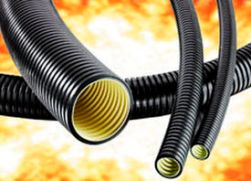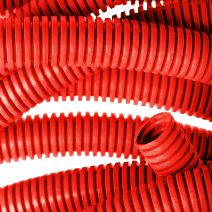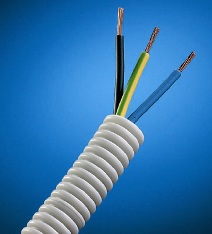Categories: Featured Articles » Electrician at home
Number of views: 133924
Comments on the article: 45
Corrugated pipe for electrical wiring
What is a corrugated pipe?
 One of the simplest, but at the same time brilliant inventions of mankind is a corrugated pipe (corrugated pipe). Why is she so wonderful?
One of the simplest, but at the same time brilliant inventions of mankind is a corrugated pipe (corrugated pipe). Why is she so wonderful?
Corrugated pipe - this pipe with a variable cross-section. Short sections with thin walls and a small diameter are interspersed in it by sections with thicker walls and a large diameter. At the same time, thick-walled sections give the pipe rigidity in the transverse direction and the ability to withstand impacts and loads, while thin-walled sections allow the pipe to bend at almost any angle and even stretch within limits depending on the type and total length of the pipe.
The corrugated pipe can be metal, but most often it is made of plastic. The flexibility and durability of the corrugated pipe predetermined its widespread use: it is used both in the ducts of ventilation and exhaust systems, and in plumbing to connect drain siphons to sewers, and in air conditioners for condensate drainage. And for the installation of cable lines for electrical wiring and various other networks used special electrical corrugated pipe (corrugation) made of PVC.
Advantages and disadvantages of corrugated plastic pipes
Pros:
-
it is convenient to apply when laying on uneven surfaces and with turns;
-
fireproof;
-
protect the cable from mechanical damage and high humidity;
-
protect people from electric shock.
Minuses:
-
it easily bursts and breaks in the cold, so for outdoor applications it is better to purchase corrugated metal pipes.
Structural features of an electrical corrugated pipe
 If you cut the electrical corrugation along, you can make sure that its profile is rectangular. Polyvinyl chloride is a fairly tough material, and the length of small diameter sections of an electrotechnical corrugation is not very large, so it is not stretched as much as many other types of corrugated pipes. But its flexibility is literally on top, especially for corrugations of small diameter.
If you cut the electrical corrugation along, you can make sure that its profile is rectangular. Polyvinyl chloride is a fairly tough material, and the length of small diameter sections of an electrotechnical corrugation is not very large, so it is not stretched as much as many other types of corrugated pipes. But its flexibility is literally on top, especially for corrugations of small diameter.
The main distinguishing feature of the electrotechnical corrugation is the presence in the internal cavity of the broach - a thin steel wire designed to tighten the bundles into the pipe. The color of the corrugation for wires is usually gray in various shades, but foreign corrugation can be blue, red, and, possibly, some other colors.
When purchasing an electrical corrugation, it is necessary to take into account the fact that the diameter given in the catalog is external. It differs from the inner diameter intended for placement of wires by at least several millimeters upwards. Therefore, it is very easy to be deceived by calculating the total diameter of the wire harness and choosing, without looking, a corrugation of the same diameter.
In general, the running diameters of the corrugation for wires vary from 16 to 50 millimeters. Less often you can get a pipe of a smaller or larger diameter. The construction length of the corrugation bays depends on the diameter. So the corrugation with a diameter of 16 mm is supplied in bays of one hundred meters long, and the length of the corrugation bay with a diameter of 50 mm is only 20 meters.
Installation of wiring in a corrugated pipe
 Due to the fact that for the manufacture electrical corrugation Since PVC is not burning and does not emit caustic smoke, the wiring in the corrugation can be mounted on any building structures, including wooden ones. Often corrugation is also used for mounting wiring for cladding in wooden houses, although smooth rigid pipes are strongly recommended by the rules in this case.
Due to the fact that for the manufacture electrical corrugation Since PVC is not burning and does not emit caustic smoke, the wiring in the corrugation can be mounted on any building structures, including wooden ones. Often corrugation is also used for mounting wiring for cladding in wooden houses, although smooth rigid pipes are strongly recommended by the rules in this case.
Installation of wiring in the corrugated pipe begins with the determination of the required length of the corrugation. Then the necessary piece of pipe is cut with a knife. Steel broach is eaten by side cutters, and here it is very important not to “miss” the broach, not to let it go inside the pipe.This can happen due to the fact that the wire inside the corrugation always has some stretch. Having gone inside, she will rest against the pipe with a rigid end, and it will be possible to get it only by making a new incision in another place. In order not to get into such an unpleasant situation, the broach should be held with your fingers during a snack, and after that it should be pulled out a little and bent along the pipe.
The wiring harness to be installed in the pipe must be prepared, fastened with electrical tape along the entire length at regular intervals. It is better to use electrical tape not cotton, but PVC, since the latter is smoother and does not create excess friction.
The end of the harness, which will be pulled into the corrugation, must be securely connected to the broach. Electricians do it differently. Someone simply wraps a harness around with steel wire, squeezing and pulling it with pliers. And someone considers it necessary to puncture several times with a broach the outer insulation of the bundle cables for a more efficient connection. In any case, the resulting structure is tightly wrapped with electrical tape so that the ends of the cables do not stick out to the sides and do not abut the bends of the corrugation. The longer the junction of the broach and the harness will be, the more reliable it will be. Therefore, saving is not recommended.
 After preparing the harness and connecting it with a broach, it is necessary to proceed to the most crucial part: tightening the harness into the corrugation. This job is easier to do together. One person holds the broach tight, and the other pulls the corrugation on top of the tourniquet. You can cope alone if you securely fix the broach, for example, winding it to some element of building structures. In any case, it is desirable to have free space for stretching the corrugation and strong hands, capable of pulling the corrugation monotonously and with great effort.
After preparing the harness and connecting it with a broach, it is necessary to proceed to the most crucial part: tightening the harness into the corrugation. This job is easier to do together. One person holds the broach tight, and the other pulls the corrugation on top of the tourniquet. You can cope alone if you securely fix the broach, for example, winding it to some element of building structures. In any case, it is desirable to have free space for stretching the corrugation and strong hands, capable of pulling the corrugation monotonously and with great effort.
If the connection of the broach and the harness was not reliable enough, or the harness was pulled through a sharp bend, the broach can come off and fly out of the pipe. In this case, you will have to cut the corrugation and make it from pieces, connecting them with electrical tape. Such a scenario, of course, is simply undesirable, therefore it is better to observe extreme caution throughout the work with corrugation and tow.
After the harness is tightened, the corrugated pipe is attached to the wall or ceiling. For fastening, you can use an aluminum mounting strip or special plastic clips that are selected according to the diameter of the pipe and sold individually. Fasteners are located on structures at approximately equal intervals to avoid sagging of the corrugation, which has a tangible weight due to the presence of a harness inside.
When connecting sockets and switches, as well as when entering harnesses in junction boxes, it is better to hide the end of the corrugation inside, so that there are no bare cable sections. For this purpose, sockets, switches and boxes with rubber sealing devices cut to the corrugation diameter are purchased. The latter is especially true for outdoor wiring.
Despite the fact that the appearance of the wiring in the corrugated pipe is not considered particularly demanding, in the presence of skill and experience, its installation can be done quite accurately. At the same time, for such premises as, for example, a country house, or a summer cottage, the device of such wiring will be a practical solution that will save a lot of money.
Alexander Molokov
See also at i.electricianexp.com
:
